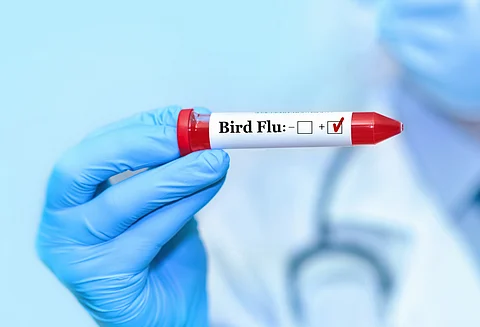

The highly pathogenic avian influenza (HPAI) evolved rapidly in 2024, jumping from birds to other species, raising global concerns. Since late 2023, the virus infected at least 48 mammal species, including pigs in the United States, cats and even tigers in Vietnam, where an outbreak killed close to 50 captive big cats.
Infections spread from cattle to humans, but the news of a Canadian teenager infected with a different strain of the virus raised alarms. A new airborne strain now poses a heightened threat to humans.
The virus’s spread was also linked to shifting migratory patterns due to climate change. While advances in gene editing offer hope for disease-resistant animals, experts warn of zoonotic spillovers. With growing outbreaks reported globally in 2024, H5N1 remains a looming pandemic risk requiring urgent action.
The outbreak of bird flu or avian influenza A (H5N1), a strain of HPAI, is likely to have started in December 2023 or early January, a primary genomic analysis revealed. The first case of the strain jumping from wild birds was announced on March 25, 2024.
HPAI was first detected in poultry in 1996, but its newer sub-types and clades, particularly since 2021, have transformed it into a major threat capable of triggering a flu pandemic. Since 2021, the virus has affected at least 485 species from 25 avian groups and 48 new mammal species. By June this year, 142 outbreaks of HPAI had been reported in animals globally, including penguins and polar bears. Down To Earth looked at how it evolved as a potential trigger for another pandemic.
The spread of H5N1 among animals was unprecedented — with the United Nations calling it “a global zoonotic animal pandemic.” The discoveries of the virus on farms, alongside recent analysis of viral dispersal patterns, reiterated the importance of climate change shifting the migratory patterns of birds in the spread of viruses.
A pre-print paper raised concerns about the potential role of cats in the spread of avian influenza, highlighting the need for increased surveillance of the virus in felines. Domestic cats could be a pathway for zoonotic spillover of avian influenza viruses to humans, the paper said.
In July, anxiety was rife among small and medium poultry farmers of Kuttanad, Kerala’s rice bowl, after a state panel recently recommended a ban on the sale and transportation of poultry birds till next March due to fears of the deadly avian flu.
An outbreak of H5N1 bird flu ravaged Vietnam’s captive tiger population, claiming the lives of 47 individuals. The outbreak affected two zoos in southern Vietnam, which also infected and killed three lions and a panther. At the My Quynh safari park in Long An province, 27 tigers, three lions and a panther succumbed to the virus in August and September 2024.
The detection of H5N1 in a pig on a backyard farm in Oregon, United States, on October 31 raised concerns due to the virus’s infection of a new mammalian host. The US Centers for Disease Control and Prevention issued a statement on November 4, expressing concern over the virus’s adaptability in pigs, which are known to be susceptible to influenza viruses affecting humans, birds and other animals.
Recent advances in gene editing technology could potentially be used to create disease-resistant animals. This could curtail the spread of avian influenza, commonly known as bird flu.
A strain of the avian flu virus infected a teenager in the Canadian province of British Columbia in November — but it was different from that responsible for infection in dairy cows and other animal outbreaks reported in the United States.
In December, a new strain of avian flu was found to show a low infectious rate but a heightened ability to infect through air as compared to its earlier variants, a study revealed. The strain, recently extracted from polecat, mink and an infected Texas-based dairy worker in the United States, exhibited an increased ability to transmit by air.